| Tārā | |
|---|---|
 13th century Tibetan painting of Green Tara, considered to be the main form of the deity | |
| Sanskrit | तारा
Tārā |
| Chinese | (Traditional) 多羅菩薩 (Simplified) 多罗菩萨 (Pinyin: Duōluó Púsà) 度母 (Pinyin: Dùmǔ) |
| Japanese | 多羅菩薩 (romaji: Tara Bosatsu) |
| Korean | 다라보살
(RR: Dara Bosal) |
| Mongolian | Ногоон дарь эх |
| Tagalog | Tala |
| Thai | พระนางตารา |
| Tibetan | རྗེ་བརྩུན་སྒྲོལ་མ།། |
| Vietnamese | Đa La Bồ Tát Độ Mẫu |
| Information | |
| Venerated by | Mahāyāna, Vajrayāna |
| Part of a series on |
| Tibetan Buddhism |
|---|
 |
Tara (Sanskrit: तारा, tārā; Standard Tibetan: སྒྲོལ་མ, dölma), Ārya Tārā (Noble Tara), also known as Jetsün Dölma (Tibetan: rje btsun sgrol ma, meaning: "venerable mother of liberation"), is an important figure in Buddhism, especially revered in Vajrayana Buddhism and Mahayana Buddhism. She appears as a female bodhisattva in Mahayana Buddhism, and is considered to be the consort or shakti of Avalokiteshvara.[1] Tārā is also known as a saviouress who hears the cries of beings in saṃsāra and saves them from wordly and spiritual danger.[2]
In Vajrayana, she is considered to be a Buddha, and the Tārā Tantra describes her as “a mother who gives birth to the buddhas of the three times” who is also "beyond saṃsāra and nirvāṇa."[3] She is one of the most important female deities in Vajrayana and is found in sources like the Mañjuśrīmūlakalpa, and the Guhyasamāja Tantra.[4] Key Indic Vajrayana texts which focus on Tārā include the Tantra Which is the Source for All the Functions of Tārā, Mother of All the Tathagatas (Skt. Sarvatathāgatamātṛtārāviśvakarmabhavanāmatantra) and Tārā’s Fundamental Ritual Text (Tārāmūlakalpa).[5][3]
Tārā remains a popular meditation deity (yidam) in Tibetan Buddhism and she is also revered in Newar Buddhism. Tārā is considered to have many forms or emanations, and there are several traditions which list twenty-one Tārās, each with different colors, implements, number of faces and arms and activities such as pacifying (śānti), increasing (pauṣṭika), enthralling (vaśīkaraṇa), and assaulting (abhicāra).[2] The green (or "blue-green", Skt. śyāmatārā) form of Tārā remains the most important form of the deity in the Tibetan tradition.[6][7] A practice text entitled Praise to Tara in Twenty-One Homages is the most important text on Tara in Tibetan Buddhism and is the source for the various traditions which list twenty one forms of Tārā (aside from the main green form).
The main Tārā mantra is the same for Buddhists and Hindus alike: oṃ tāre tuttāre ture svāhā. It is pronounced by Tibetans and Buddhists who follow the Tibetan traditions as oṃ tāre tu tāre ture soha. The literal translation would be "Oṃ O Tārā, I pray O Tārā, O Swift One, So Be It!"
Etymology
Tārā (तारा) is a feminine noun which means "star" or "planet".[8]
It evolved from: Avalokiteśvara IPA: /ˌʌvəloʊkɪˈteɪʃvərə/, Sanskrit, "Down [upon Earth('s sentients')(sounds)] looking lord", implicit interpolation of sounds indicated in recent philology though the verb is for sight, male in original form though evolved, especially in Tibet as female Tara and in China as female 觀音 (traditional) 观音 (simplified) Guānyīn (Pinyin Mandarin pronunciation), Chinese, "Attending to [hearing] the sounds [of Earth, especially sounds of suffering] [divine personage, often made explicit as Boddhisattva by further appending that title]"[9][10][11]
ध्रुव Dhruvá, Sanskrit, male noun, North Star, iconically fixed star
རྗེ་བརྩུན་སྒྲོལ་མ།།, སྒྲོལ་མ (Jetsun) Sgrol ma or D(r)ölma, or rje btsun ma (Wylie), Tibetan, Dzongkha (national language of Bhutan), "(Venerable (feminine)) Saviour" from sgrol ba, Tibetan, verb, "to save, rescue, liberate; to carry, transport, or cross; and to expel or drive away [evil]" + ma.Tibetan.mother.[12][13]
多羅菩薩 たらぼさつ Tara Bosatsu, Japanese, from 多羅菩薩 Duōluó Púsà (Pinyin Mandarin pronunciation), Chinese, Much Gatherer Bodhisattva.[14]
ताराष्टोत्तरशतनामावली Tārāṣṭottaraśatanāmāvalī, Sanskrit, "108 Names of [Divine Personage] Tara", ia a commonly associated set of 108 alternate names and epithets.[15][16][17]
Emergence as a Buddhist deity
_Attended_by_Sita_Tara_(White_Tara)_and_Bhrikuti_LACMA_M.84.32.1a-d.jpg.webp)


Buddhist studies scholars generally agree that the worship of Tara began growing in popularity in India during the 6th century.[2] Tārā came to be seen as an expression of the compassion of perfected wisdom only later, with her earliest textual reference being the Mañjuśrī-mūla-kalpa (c. 5th–8th centuries CE).[18] The earliest, solidly identifiable image of Tārā is most likely that which is still found today at cave 6 within the rock-cut Buddhist monastic complex of the Ellora Caves in Maharashtra (c. 7th century CE), with her worship being well established by the onset of the Pala Empire in Eastern India (8th century CE).[19]
The origin of Tārā is unclear and remains a source of inquiry among scholars. Mallar Ghosh believes her to have originated as a form of the goddess Durga in the Hindu Puranas.[20] Today, she is worshiped both in Buddhism as well as in Shaktism (Hinduism) as one of the ten Mahavidyas. According to Beyer, it would seem that the feminine principle makes its first appearance in Buddhism as Prajñāpāramitā Devi, the personified Prajñāpāramitā, who is also called mother of Buddhas.[21]
Tārā became a very popular Vajrayana deity with the rise of Tantra in 8th-century Pala and, with the movement of Indian Buddhism into Tibet through Padmasambhava, the worship and practices of Tārā became incorporated into Tibetan Buddhism as well.[21][22] She eventually came to be considered the "Mother of all Buddhas", which usually refers to the enlightened wisdom of the Buddhas, while simultaneously echoing the ancient concept of the Mother Goddess in India.
Independent of whether she is classified as a deity, a Buddha, or a bodhisattva, Tārā remains very popular in Tibet (and Tibetan communities in exile in Northern India), Mongolia, Nepal, Bhutan, Sikkim and is worshiped in a majority of Buddhist communities throughout the world (see also Guanyin, the female aspect of Avalokitesvara in Chinese Buddhism). In Tibet, Green Tārā was considered to have manifested as the Nepalese Princess (Bhrikuti),[23] and White Tārā's manifestation as the Chinese princess Kongjo (Princess Wencheng).[24]
Today, Green Tara and White Tara are probably the most popular representations of Tara. Green Tara is usually associated with protection from fear and the following eight obscurations: lions (= pride), wild elephants (= delusion/ignorance), fires (= hatred and anger), snakes (= jealousy), bandits and thieves (= wrong views, including fanatical views), bondage (= avarice and miserliness), floods (= desire and attachment), and evil spirits and demons (= deluded doubts).
As one of the three deities of long life, White Tara is associated with longevity. White Tara counteracts illness and thereby helps to bring about a long life. She embodies the motivation that is compassion and is said to be as white and radiant as the moon.
Origin myth

Tārā has many origin stories which explain her origin as a bodhisattva. According to one story, Tārā arose from Avalokiteshvara's compassionate tears when he wept on seeing all the suffering of all the beings in samsara. His tears turned into a lotus, out of which Tārā arose.[25] Sūryagupta explains this myth as follows:
What was Her origin? - Arya-Lokesvara, the Lord and Refuge of the Three Realms, Desire, Form, and Formless, which depend on the five or [in the Formless Realm] four aggregates that perish in an instant, saw that however many migrating beings he removed from samsara, they grew no fewer, and He wept. Tara sprang from the opening filaments of his face - of an utpala (blue lotus) that grew in the water of His tears.[26]
Another tale begins with a young princess who lives in a different world system, millions of years in the past. Her name is Jñanachandra or Yeshe Dawa, which means "Moon of Primordial Awareness". For quite a number of aeons she makes offerings to the Buddha of that world system, whose name was Tonyo Drupa. She receives special instruction from him concerning bodhicitta—the infinitely compassionate mental state of a bodhisattva. After doing this, some monks approach her and suggest that because of her level of attainment she should next pray to be reborn as a male to progress further.
At this point she lets the monks know in no uncertain terms that it is only "weak minded worldlings" who see gender as a barrier to attaining enlightenment. She sadly notes there have been few who wish to work for the welfare of sentient beings in a female form, though. Therefore, she resolves to always be reborn as a female bodhisattva, until samsara is no more.[27] She then stays in a palace in a state of meditation for some ten million years, and the power of this practice releases tens of millions of beings from suffering. As a result of this, Tonyo Drupa tells her she will henceforth manifest supreme bodhi as the Goddess Tārā in many world systems to come.
A similar story is told by the 14th Dalai Lama:
There is a true feminist movement in Buddhism that relates to the goddess Tārā. Following her cultivation of bodhicitta, the bodhisattva's motivation, she looked upon the situation of those striving towards full awakening and she felt that there were too few people who attained Buddhahood as women. So she vowed, "I have developed bodhicitta as a woman. For all my lifetimes along the path I vow to be born as a woman, and in my final lifetime when I attain Buddhahood, then, too, I will be a woman.[28]
Tārā, then, embodies certain ideals which make her attractive to women practitioners, and her emergence as a Bodhisattva can be seen as a part of Mahayana Buddhism's reaching out to women, and becoming more inclusive even in 6th-century CE India.
Symbols and associations
Tārā's name literally means "star" or "planet", and therefore she is associated with navigation and travel both literally and metaphorically as spiritual crossing to the 'other side' of the ocean of existence (enlightenment).[8] Hence she is known literally as "she who saves" in Tibetan.[29] In the 108 Names of the Holy Tara, Tara is 'Leader of the caravans ..... who showeth the way to those who have lost it' and she is named as Dhruva, the Sanskrit name for the North Star.[29]
According to Miranda Shaw, "Motherhood is central to the conception of Tara".[30] Her titles include "loving mother", "supreme mother", "mother of the world", "universal mother" and "mother of all Buddhas".[31]
She is most often shown with the blue lotus or night lotus (utpala), which releases its fragrance with the appearance of the moon and therefore Tārā is also associated with the moon and night.[32][29]
Tārā is also a forest goddess, particularly in her form as Khadiravani, "dweller in the Khadira forest" and is generally associated with plant life, flowers, acacia (khadira) trees and the wind. Because of her association with nature and plants, Tārā is also known as a healing goddess (especially as White Tārā) and as a goddess of nurturing quality and fertility.[33] Her pure land in Mount Potala is described as "Covered with manifold trees and creepers, resounding with the sound of many birds, And with murmur of waterfalls, thronged with wild beasts of many kinds; Many species of flowers grow everywhere."[34] Her association with the wind element (vaayu) also means that she is swift in responding to calls for any aid.
As a saviouress

Tārā also embodies many of the qualities of feminine principle. She is known as the Mother of Mercy and Compassion. She is the source, the female aspect of the universe, which gives birth to warmth, compassion and relief from bad karma as experienced by ordinary beings in cyclic existence. She engenders, nourishes, smiles at the vitality of creation, and has sympathy for all beings as a mother does for her children. As Green Tārā she offers succor and protection from all the unfortunate circumstances one can encounter within the samsaric world. As White Tārā she expresses maternal compassion and offers healing to beings who are hurt or wounded, either mentally or psychically. As Red Tārā she teaches discriminating awareness about created phenomena, and how to turn raw desire into compassion and love. As Blue Tārā (Ekajati) she becomes a protector in the Nyingma lineage, who expresses a ferocious, wrathful, female energy whose invocation destroys all Dharmic obstacles that engender good luck and swift spiritual awakening.[21]
Within Tibetan Buddhism, she has 21 major forms in all, each tied to a certain color and energy. And each offers some feminine attribute, of ultimate benefit to the spiritual aspirant who asks for her assistance.
Another quality of feminine principle which she shares with the dakinis is playfulness. As John Blofeld expands upon in Bodhisattva of Compassion,[35] Tārā is frequently depicted as a young sixteen-year-old girlish woman. She often manifests in the lives of dharma practitioners when they take themselves, or the spiritual path too seriously. There are Tibetan tales in which she laughs at self-righteousness, or plays pranks on those who lack reverence for the feminine. In Magic Dance: The Display of the Self-Nature of the Five Wisdom Dakinis, Thinley Norbu explores this as "Playmind".[36] Applied to Tārā one could say that her playful mind can relieve ordinary minds which become rigidly serious or tightly gripped by dualistic distinctions. She takes delight in an open mind and a receptive heart then. For in this openness and receptivity her blessings can naturally unfold and her energies can quicken the aspirants spiritual development.
These qualities of feminine principle then, found an expression in Indian Mahayana Buddhism and the emerging Vajrayana of Tibet, as the many forms of Tārā, as dakinis, as Prajnaparamita, and as many other local and specialized feminine divinities. As the worship of Tārā developed, various prayers, chants and mantras became associated with her. These came out of a felt devotional need, and from her inspiration causing spiritual masters to compose and set down sadhanas, or tantric meditation practices. Two ways of approach to her began to emerge. In one common folk and lay practitioners would simply directly appeal to her to ease some of the travails of worldly life. In the second, she became a Tantric deity whose practice would be used by monks or tantric yogis in order to develop her qualities in themselves, ultimately leading through her to the source of her qualities, which are enlightenment, enlightened compassion, and enlightened mind.
Tantric deity

.jpg.webp)
Tārā as a focus for tantric deity yoga can be traced back to the time period of Padmasambhava. There is a Red Tārā practice which was given by Padmasambhava to Yeshe Tsogyal. He asked that she hide it as a treasure. It was not until the 20th century, that a great Nyingma lama, Apong Terton rediscovered it. It is said that this lama was reborn as Sakya Trizin, present head of the Sakyapa sect. A monk who had known Apong Terton succeeded in retransmitting it to Sakya Trizin, and the same monk also gave it to Chagdud Tulku Rinpoche, who released it to his western students.
Martin Willson in In Praise of Tārā traces many different lineages of Tārā Tantras, that is Tārā scriptures used as Tantric sadhanas.[37] For example, a Tārā sadhana was revealed to Tilopa (988–1069 CE), the human father of the Karma Kagyu. Atisa, the great translator and founder of the Kadampa school of Tibetan Buddhism, was a devotee of Tārā. He composed a praise to her, and three Tārā Sadhanas. Martin Willson's work also contains charts which show origins of her tantras in various lineages, but suffice to say that Tārā as a tantric practice quickly spread from around the 7th century CE onwards, and remains an important part of Vajrayana Buddhism to this day.
The practices themselves usually present Tārā as a tutelary deity (thug dam, yidam) which the practitioners sees as being a latent aspect of one's mind, or a manifestation in a visible form of a quality stemming from Buddha Jnana. As John Blofeld puts it in The Tantric Mysticism of Tibet:
The function of the Yidam is one of the profound mysteries of the Vajrayana...Especially during the first years of practice the Yidam is of immense importance. Yidam is the Tibetan rendering of the Sanskrit word "Iṣṭadeva"—the in-dwelling deity; but, where the Hindus take the Iṣṭadeva for an actual deity who has been invited to dwell in the devotee's heart, the Yidams of Tantric Buddhism are in fact the emanations of the adept's own mind. Or are they? To some extent they seem to belong to that order of phenomena which in Jungian terms are called archetypes and are therefore the common property of the entire human race. Even among Tantric Buddhists, there may be a division of opinion as to how far the Yidams are the creations of individual minds. What is quite certain is that they are not independently existing gods and goddesses; and yet, paradoxically, there are many occasions when they must be so regarded.[38]
Forms

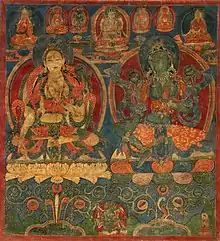

There are many forms of Tārā, including various popular lists of 21 different forms or emanations of Tārā. "Green Tārā" (Skt. śyāmatārā), who is associated with peacefulness and enlightened activity, is the most depicted form of the goddess in Indo-Tibetan Buddhism. This is generally considered Tārā's main form, out of which the other twenty one forms arise.[39] One common variation of Green Tārā is known as Khadiravaṇi-Tārā (Tārā of the acacia forest) and appears in a forest with flowers in her hair while accompanied by her two attendants Mārīcī and Ekajaṭā.[39]
Another popular form is White Tārā (Sitatārā), often shown with two arms seated on a white lotus and with eyes on her hand and feet, as well as a third eye on her forehead (thus she is also known as "Seven eyed"). She is known for compassion, long life, healing, and serenity.[40]
Tārā is generally considered to have many forms, all of which are various adaptations to the needs of all living beings.[41] According to Dharmachari Purna:
Tārā is in fact the name of a whole class of deities. She appears in all the five colours of the Jinas. There are at least ten green forms, seven white, five yellow, two blue and one red. As Sarvajñamitra says of her form: 'It is a universal form, varied like crystal, since it changes according to circumstance'.She has both peaceful and wrathful forms. Her figure is shown in virtually all postures from standing to sitting, full lotus, half lotus, one leg down, and both legs down. There is apparently also a reclining Tārā. She has two-armed forms, four arms, eight arms, twelve arms, and Getty even mentions a Tibetan painting showing a standing Tārā with 'one thousand heads and arms'. Ghosh lists seventy-six distinct forms of Tārā, and tradition tells us there are one hundred and eight names for her.[29]
There are numerous lists of "twenty one Tārās" found in Tibetan Buddhism, a tradition which is found in the Indic sources as well, beginning with the tantric The Praise in Twenty-one Homages (Skt. Namastāraikaviṃśatistotraguṇahitasahita, in full: The Praise to Tara with Twenty-One Verses of Homage, and the Excellent Benefits of Reciting the Praise, Derge no. 438). Indian authors like Sūryagupta (a.k.a. Ravigupta, c. 7th-8th century), Candragomin and Atisha also wrote texts discussing "twenty one Tārās" and the Tārā lineages of these figures are still found in Tibetan Buddhism. Another different list is found in the Indian Sadhanamala.[42]
These Indian lineages have lists which contain different forms of Tārā. There are also other Tibetan lineages with different lists of twenty one forms of Tārā, including that of Longchenpa, Jigme Lingpa and Choggyur Lingpa.[42]
Nine Tārā mandala
The Tārā Tantra contains a mandala of nine Tārās, each one is a different color, but all are depicted as young women covered in jewels, with earrings and ornaments. The nine Tārās are:[2]
- Green Tārā, with one head and two arms, who resides at the center of the mandala. One hand makes the gesture of granting boons (varada) and the other hand holds a blue utpala flower.
- Dark blue Tārā is found in the eastern quarter of the mandala. She is a youth who holds a trident and an uptala flower.
- Gold Tārā is found in the southern quarter of the mandala. She holds a sword and an utpala flower.
- Red Tārā is found in the western quarter of the mandala. She holds a wheel and an utpala flower.
- Green Tārā in the northern quarter of the mandala. She holds a parasol and an utpala flower.
- Hook Tārā in the eastern gate of the mandala. She is white, wrathful, and carries a hook in each hand.
- Lasso Tārā in the southern gate of the mandala. She is yellow, wrathful, and carries a lasso in each hand.
- Shackles Tārā in the western gate, red skinned, wrathful, holding shackles.
- Bell Tārā in the northern gate, blue-green colored, wrathful, holding a bell in each hand.
Sūryagupta's Tārās
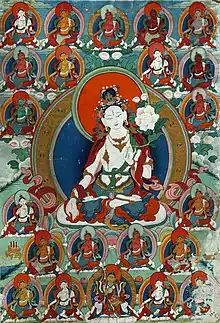
Sūryagupta was a devotee of Tārā and wrote at least five commentaries on the Praise in Twenty-One Homages. His explanation of various forms of Tārā is the earliest one in the Indian tradition.[42] In his tradition, which has been widely studied by scholars, each form of the goddess has different attributes, color and activity (such as pacifying, magnetizing, longevity, subduing enemies, etc).[42]
Each form of Tārā also goes by slightly different names. The Sūryagupta list of Tārās actually contains twenty two forms, with one main or central deity, which is Green Tārā, Khadiravaṇī, who is blue-green, and the twenty one Tārās. The order of the list below follows Sūryagupta's commentary:[6][7]
- Swift Courageous Tārā or Heroic Tārā (Skt. Tārā Tura-vīrā or Tārā Pravīrā) - red in color "radiating fiery light, [with] one face with two eyes, and eight arms." Her arms hold various weapons like a bow and arrow. This Tārā controls and reverses negative and evil influences, both internal and external influences.
- Tārā White like the Autumn Moon or Brilliant Moon Tārā (Skt. Tārā Śuklakānti or Tārā Candra-kānti), this is a three faced twelve armed white Tārā with peaceful powers, she is particularly known for the pacification of defilement and disease. The three faces represent the trikaya.
- Golden Coloured Tārā (Skt. Tārā Kanaka-varṇī), this ten armed gold Tārā specializes in the activity of increasing: increasing lifespan, resources, and wisdom
- Tārā Crown Jewel the Tathāgatas or Victorious Crown Jewel Tārā (Skt. Tārā Tathāgatoṣṇīṣā or Tārā Uṣṇīṣa-vijayā), the uṣṇīṣa is a protuberance on the Buddha’s head, this four armed gold Tārā is known for neutralizing poison, increasing life and preventing premature death.
- Tārā sounding Hūṃ (Skt. Tārā Hūṃ-kāra-nādinī or Tārā Hūṃ-svara-nādinī), slight fierce in countenance and golden color. She is shown stamping her feet, an act that sounds the syllable Hūṃ, which reverses negative influences and draws sentient beings to the Dharma.
- Tārā, Victor Over the Three Worlds (Skt. Tārā Trailokavijayā), depicted ruby red or reddish black, this Tārā subdues and controls all deities and spirits, including devas like Indra and Agni as well as yakshas. She also purifies obscurations and negativities.
- Destroyer Tārā or Enemy crusher Tārā (Skt. Tārā Pramardinī or Tārā Apavādi-pramardanī), a fierce black Tārā with a wrathful looking face holding a sword who is known for subduing dark and demonic forces, external and internal. She is also associated with a phowa ritual which transfers the mindstream to the pure land at the time of death.
- Mara destroyer Tārā (who bestows excellence) (Skt. Tārā Māra-mardaneśvarī or Tārā Māra-sūdanī-vaśitottama-dā) - a golden colored Tārā with a fierce frown who can destroy the four Maras (death, the defiled aggregates, the defilements, and the Mara the deity) which are the obstacles to awakening.
- Tārā of the Khadira Forest (Skt. Tārā Khadira-vaṇī), a "shining blue-green" Tārā who holds a blue lotus and appears in a lush forest of fragrant Khadira trees. She is depicted accompanied by Marici and Ekajata. She is the principal Tārā in the Sūryagupta tradition. Interestingly enough
- Tārā granter of boons (Skt. Tārā Vara-dā), is sometimes depicted as a red Tārā who grants all precious things to all beings.
- Tārā dispeller of sorrow (Skt. Śoka-vinodana Tārā), a red Tārā who fulfills desires and subjugates evil
- Tārā magnetiser of all beings (dispeller of misfortune) (Skt. Tārā Jagad-vaśī or Tārā Jagad-vaśī-riṣṭa-nirvahaṇī), her power is to increase enjoyments, and wealth, she is the "color of darkness".
- Auspicious light Tārā or Tārā giver of prosperity (Skt. Tārā Maṅgalālokā or Kalyāna-dā Tārā), a gold Tārā with eight arms and a crescent moon ornament. She gives off a white light for pacifying negativities and a yellow light for increasing goodness. She is sometimes depicted with Amitabha at her crown.
- Tārā who ripens all (Skt. Tārā Paripācakā), a red fierce looking Tārā depicted amid a cosmic fire. She subdues the hindrances and protects from fear and danger.
- Furrowed Brow Tārā, or Tārā the enthraller of all (Skt. Tārā Bhṛkuṭī or Tārā Vaśīkārī), a dark Tārā with three wrathful faces and a necklace of skulls. She is shown dancing, trampling a corpse and stamping her foot. She destroys all things which interfere with the Dharma and the welfare of sentient beings.
- Great peaceful Tārā (Skt. Tārā Mahā-śānti), a white peaceful Tārā with six arms, associated with happiness, purification and pacification of negative karma
- Tārā destroyer of attachment (Skt. Tārā Rāga-niṣūdanī), a beautiful red Tārā holding a trident who amplifies the power of mantras and removes negative thoughts.
- Tārā who accomplishes bliss (Skt. Tārā Sukha-sādhanī), she is orange and holds a moon disk at her chest. She is known for eliminating dark magic mantras and for binding thieves.
- White victorious Tārā (Skt. Tārā Vijayā or Tārā Sita-vijayā), a white Tārā known for dispelling disease, particularly leprosy
- Tārā consumer of suffering (Skt. Tārā Duḥkha-dahanī), a white Tārā who eliminates conflict, nightmares, negative thoughts, and poisons. She is also associated with freedom from prison.
- Tārā giver of attainments (Skt. Tārā Siddhi-saṃbhavā) an orange Tārā who grants special powers (siddhis) like invisibility and also heals diseases
- Tārā who perfects all (Skt. Tārā Pari-pūraṇī), a white Tārā sitting on a bull who can take one to the Pure land of Akanishta
Other Tārās


Other forms of Tārā include:
- Kurukullā (Rigjema) of red color and fierce aspect associated with magnetizing all good things
- Black Tārā (Ugra Tārā), associated with power
- Various forms of Yellow or Golden colored Tārās, sometimes associated with wealth and prosperity including "Yellow Cintamani Tārā" ("Wish-Granting Gem Tara") holding a wish granting jewel, eight armed "Vajra Tārā" and golden "Rajasri Tārā" holding a blue lotus.[43]
- "Blue Tārā", wrathful with many heads and arms, associated with transmutation of anger. Some authors believe her to be identical with Ugra Tārā and Ekajati.[44]
- Cintāmaṇi Tārā, a form of Tārā widely practiced at the level of Highest Yoga Tantra in the Gelug School of Tibetan Buddhism, portrayed as green and often conflated with Green Tārā
- The Indic deity Sarasvati (Yangchenma), known for the arts, knowledge and wisdom, is sometimes seen as a form of Tārā
- Golden Prasanna Tārā – a wrathful form, with a necklace of bloody heads and sixteen arms holding an array of weapons and Tantric attributes.
- Sitatapatra Tārā, protector against supernatural danger
- Yeshe Tsogyal ("Wisdom Lake Queen"), the consort of Padmasambhava who brought Buddhism to Tibet, is seen as an emanation of Tārā in Tibetan Buddhism.
- Rigjay Lhamo, "Goddess Who Brings Forth Awareness", seated in royal posture surrounded by rainbow light.
Tārā's iconography such as the lotus also shows resemblance with the Hindu goddess Lakshmi, and at least one Tibetan liturgy evokes Lakshmi as Tārā.[45] According to Shaw, there is a later trend of Tārā theology that began to see all other female divinities as aspects of Tārā or at least associated with her. Apart from her many emanations named Tārā of varying colors, other Mahayana female divinities that became part of Tara's theology include Janguli, Parnasabari, Cunda, Kurukulla, Mahamayuri, Usnisavijaya, and Marici. Based on this principle of Tārā as the central female divinity, while other Devis and Dakinis were also seen as emanations of her.[46]
Vajrayana texts

Sadhanas in which Tārā is the yidam (meditational deity) can be extensive or quite brief. Most all of them include some introductory praises or homages to invoke her presence and prayers of taking refuge. Then her mantra is recited, followed by a visualization of her, perhaps more mantra, then the visualization is dissolved, followed by a dedication of the merit from doing the practice. Additionally there may be extra prayers of aspirations, and a long life prayer for the Lama who originated the practice. Many of the Tārā sadhanas are seen as beginning practices within the world of Vajrayana Buddhism, however what is taking place during the visualization of the deity actually invokes some of the most sublime teachings of all Buddhism.
In this case during the creation phase of Tārā as a yidam, she is seen as having as much reality as any other phenomena apprehended through the mind. By reciting her mantra and visualizing her form in front, or on the head of the adept, one is opening to her energies of compassion and wisdom. After a period of time the practitioner shares in some of these qualities, becomes imbued with her being and all it represents. At the same time all of this is seen as coming out of Emptiness and having a translucent quality like a rainbow. Then many times there is a visualization of oneself as Tārā. One simultaneously becomes inseparable from all her good qualities while at the same time realizing the emptiness of the visualization of oneself as the yidam and also the emptiness of one's ordinary self.

This occurs in the completion stage of the practice. One dissolves the created deity form and at the same time also realizes how much of what we call the "self" is a creation of the mind, and has no long term substantial inherent existence. This part of the practice then is preparing the practitioner to be able to confront the dissolution of one's self at death and ultimately be able to approach through various stages of meditation upon emptiness, the realization of Ultimate Truth as a vast display of Emptiness and Luminosity. At the same time the recitation of the mantra has been invoking Tārā's energy through its Sanskrit seed syllables and this purifies and activates certain energy centers of the body (chakras). This also untangles knots of psychic energy which have hindered the practitioner from developing a Vajra body, which is necessary to be able to progress to more advanced practices and deeper stages of realization.
Therefore, even in a simple Tārā sadhana a plethora of outer, inner, and secret events is taking place and there are now many works such as Deity Yoga, compiled by the present Dalai Lama,[47] which explores all the ramifications of working with a yidam in Tantric practices.
The end results of doing such Tārā practices are many. For one thing it reduces the forces of delusion in the forms of negative karma, sickness, afflictions of kleshas, and other obstacles and obscurations.
The mantra helps generate Bodhicitta within the heart of the practitioner and purifies the psychic channels (nadis) within the body allowing a more natural expression of generosity and compassion to flow from the heart center. Through experiencing Tārā's perfected form one acknowledges one's own perfected form, that is one's intrinsic Buddha nature, which is usually covered over by obscurations and clinging to dualistic phenomena as being inherently real and permanent.
The practice then weans one away from a coarse understanding of Reality, allowing one to get in touch with inner qualities similar to those of a bodhisattva, and prepares one's inner self to embrace finer spiritual energies, which can lead to more subtle and profound realizations of the Emptiness of phenomena and self.
As Chagdud Tulku Rinpoche, in his Introduction to the Red Tārā Sadhana,[48] notes of his lineage: "Tārā is the flawless expression of the inseparability of emptiness, awareness and compassion. Just as you use a mirror to see your face, Tārā meditation is a means of seeing the true face of your mind, devoid of any trace of delusion".
There are several preparations to be done before practising the Sadhana. To perform a correct execution the practitioner must be prepared and take on the proper disposition. The preparations may be grouped as "internal" and "external". Both are necessary to achieve the required concentration.
The preparations are of two types: external and internal. The external preparations consist of cleaning the meditation room, setting up a shrine with images of Buddha Shakyamuni and Green Tara, and setting out a beautiful arrangement of offerings. We can use water to represent nectar for drinking, water for bathing the feet, and perfume. For the remaining offerings—flowers, incense, light, and pure food—if possible we should set out the actual substances. As for internal preparations, we should try to improve our compassion, bodhichitta, and correct view of emptiness through the practice of the stages of the path, and to receive a Tantric empowerment of Green Tara. It is possible to participate in group pujas if we have not yet received an empowerment, but to gain deep experience of this practice we need to receive an empowerment. The main internal preparation is to generate and strengthen our faith in Arya Tara, regarding her as the synthesis of all Gurus, Yidams, and Buddhas.[49]
Tibetan revealed texts
Terma teachings are "hidden teachings" said to have been left by Padmasambhava (8th century) and others for the benefit of future generations. Jamyang Khyentse Wangpo discovered Phagme Nyingthig (Tib. spelling: 'chi med 'phags ma'i snying thig, Innermost Essence teachings of the Immortal Bodhisattva [Arya Tārā]).[50]
Earlier in the 19th century, according to a biography,[51] Nyala Pema Dündul received a Hidden Treasure, Tārā Teaching and Nyingthig (Tib. nying thig) from his uncle Kunsang Dudjom (Tib. kun bzang bdud 'joms). It is not clear from the source whether the terma teaching and the nyingthig teachings refer to the same text or two different texts.
Gallery
.jpg.webp) Gilded copper White Tara, Nepal
Gilded copper White Tara, Nepal Sandstone Tara Statue
Sandstone Tara Statue.jpg.webp) Tara c. 10-11 century, Gaya
Tara c. 10-11 century, Gaya Tara, Sarnath
Tara, Sarnath Statue of Tara, Sri Lanka, 7th–8th century
Statue of Tara, Sri Lanka, 7th–8th century.jpg.webp) Syamatara, Candi Jago, Malang, East Java, 13th c.
Syamatara, Candi Jago, Malang, East Java, 13th c.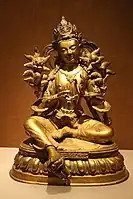 Green Tara statue, Qing dynasty
Green Tara statue, Qing dynasty Tara statue from the Qing dynasty
Tara statue from the Qing dynasty The Buddhist Goddess Tara, gold and silver, Central Java, Indonesia, c. 9th century.[52] The Walters Art Museum.
The Buddhist Goddess Tara, gold and silver, Central Java, Indonesia, c. 9th century.[52] The Walters Art Museum..jpg.webp) Tara, Mahabodhi Temple, Bodhgaya
Tara, Mahabodhi Temple, Bodhgaya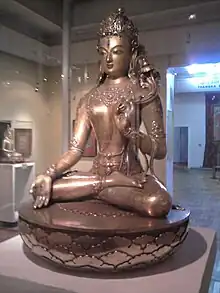 Sita (White) Tara by Öndör Gegeen Zanabazar. Mongolia, c. 17th century.
Sita (White) Tara by Öndör Gegeen Zanabazar. Mongolia, c. 17th century.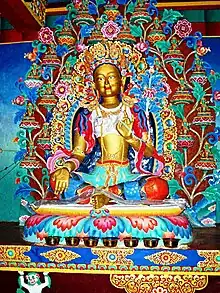 Tara statue near Kullu, Himachal Pradesh, India
Tara statue near Kullu, Himachal Pradesh, India Medititating Tara, Ratnagiri, Odisha, India, 8th century
Medititating Tara, Ratnagiri, Odisha, India, 8th century White Tara statue in a Karma Kagyu dharma centre
White Tara statue in a Karma Kagyu dharma centre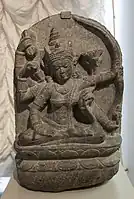 Late Pala era Tara, c. 10th-11th centuries
Late Pala era Tara, c. 10th-11th centuries%252C_Singapore_Pinacoth%C3%A8que_De_Paris_-_20160410.jpg.webp) Syamatara (Green Tārā), 9th century Javanese Shailendran art, from Central Java, Indonesia
Syamatara (Green Tārā), 9th century Javanese Shailendran art, from Central Java, Indonesia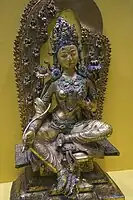 Green Tara c. 15th-16th century, copper with gilding, painted with clay and gold, held in the Tibet Museum.
Green Tara c. 15th-16th century, copper with gilding, painted with clay and gold, held in the Tibet Museum. Painting of Buddhist goddess Green Tara by Prithvi Man Chitrakari done in 1947
Painting of Buddhist goddess Green Tara by Prithvi Man Chitrakari done in 1947 Yellow Tara, Nako Monastery, India
Yellow Tara, Nako Monastery, India Qing Green Tara
Qing Green Tara Syama Tara. Reign of Qianlong, 1736-1795. Lama Temple, Beijing
Syama Tara. Reign of Qianlong, 1736-1795. Lama Temple, Beijing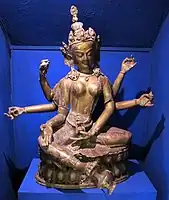 Indian bronze, Museo di storia naturale (Florence)
Indian bronze, Museo di storia naturale (Florence)
See also
- Nairatmya
- Praises to the Twenty-One Taras
- Golden Tara, Mahayana Buddhist deity's statue discovered in Philippines
- Tara (Devi)
References
Citations
- ↑ Buddhist Deities: Bodhisattvas of Compassion
- 1 2 3 4 "The Tantra on the Origin of All Rites of Tārā, Mother of All the Tathāgatas / Introduction / 84000 Reading Room". 84000 Translating The Words of The Budda. Retrieved 2024-01-13.
- 1 2 James B. Apple, “Atiśa’s System of Twenty-One Tārās”, Revue d’Etudes Tibétaines, no. 66, Avril 2023, pp. 424-463.
- ↑ Kaur, Gurmeet (January 2022). "Tara in Vajrayana Buddhism: A Critical Content Analysis". Feminist Theology. 30 (2): 210–221. doi:10.1177/09667350211055444. ISSN 0966-7350. S2CID 244052426.
- ↑ Beyer (1973), p. 13.
- 1 2 Thubten Chodron (2013) How to Free Your Mind: The Practice of Tara the Liberator, the names are found throughout all of chapter 5's commentary, Shambhala Publications.
- 1 2 Willson, Martin. 1986. In Praise of Tārā: Songs to the Saviouress. Source Texts from India and Tibet on Buddhism’s Great Goddess, pp. 124-166. London: Wisdom.
- 1 2 Shaw (2006), p. 310.
- ↑ "Avalokitesvara". Random House Webster's Unabridged Dictionary.
- ↑ Studholme p. 52-54, 57.
- ↑ Pine, Red. The Heart Sutra: The Womb of the Buddhas (2004) Shoemaker 7 Hoard. ISBN 1-59376-009-4 pg 44-45
- ↑ "སྒྲོལ་མ་ Drölma – Green Tārā, The Bodhisattva Goddess: Enlightened Feminine Wisdom in Action". Drala Mountain Center. Retrieved 28 December 2022.
- ↑ Landsman, translator, Susan A. "The Tara Tantra, ārā's Fundamental Ritual Text (Tārā-mūla-kalpa) 2020". Wisdom. Wisdom Publications. Retrieved 28 December 2022.
{{cite web}}:|last1=has generic name (help) - ↑ Buddhist Deities: Bodhisattvas of Compassion
- ↑ "108 Tara Names: Ashtottara Shatanamavali of Goddess Tara". Drikpanchang.com, Hindu Calendar for the World. Retrieved 28 December 2022.
- ↑ "108 Names Mantra of Goddess Tara in English". Temples in India info. Retrieved 28 December 2022.
- ↑ "The 108 Names of the Venerable Arya Tara, Arya Tara Bhadra Nama Ashta Shataka". Kurukulla.org. Retrieved 28 December 2022.
- ↑ Willson (1996), p. 40.
- ↑ Ghosh (1980), p. 6.
- ↑ Ghosh (1980), p. 17.
- 1 2 3 Beyer (1973), p. .
- ↑ Sherab & Dongyal (2007), p. 13.
- ↑ Sakya (1997), p. .
- ↑ Sonam Gyaltsen (1996), pp. 64–65.
- ↑ Stevens (2022), p. 6.
- ↑ Willson, Martin. 1986. In Praise of Tārā: Songs to the Saviouress. Source Texts from India and Tibet on Buddhism’s Great Goddess, pp. 124-125. London: Wisdom.
- ↑ Arni (2017).
- ↑ Dalai Lama (1992), Worlds in Harmony: Dialogues on Compassionate Action, Berkeley: Parallax Press.
- 1 2 3 4 Purna (1997)
- ↑ Shaw (2006), p. 316.
- ↑ Shaw (2006), pp. 316–317.
- ↑ Beer (2003), p. 170.
- ↑ Shaw (2006), p. 324.
- ↑ Conze (1964), p. 196.
- ↑ Blofeld (2009), p. .
- ↑ Norbu (1999), p. .
- ↑ Willson (1996), p. .
- ↑ Blofeld (1992), p. 176.
- 1 2 Shaw, Miranda (2006). Buddhist Goddesses of India, p. 325. Princeton University Press.
- ↑ Shaw (2006), p. 333.
- ↑ Shaw (2006), p. 337.
- 1 2 3 4 Stevens (2022), p. 112.
- ↑ Shaw (2006), p. 339.
- ↑ Getty (1998), pp. 125–126.
- ↑ Shaw (2006), p. 332.
- ↑ Shaw (2006), p. 341.
- ↑ Dalai Lama (14th) (1987).
- ↑ Chagdud Khadro & Chagdud Tulku (1994), "Introduction".
- ↑ Dalai Lama (1st) (2000).
- ↑ Thondup (1999), p. 218.
- ↑ Center for Dzogchen Studies Translation Group (n.d.).
- ↑ "The Buddhist Goddess Tara". The Walters Art Museum.
Works cited
- Arni, Samhita (March 9, 2017). "Gender doesn't come in the way of Nirvana". The Hindu. ISSN 0971-751X. Retrieved 2019-12-14.
- Beer, Robert (2003). A Handbook of Tibetan Buddhist Symbols. Boston: Shambhala. ISBN 978-1590301005.
- Beyer, Stephan (1973). The Cult of Tārā: Magic and Ritual in Tibet. Berkeley; Los Angeles; London: University of California Press. ISBN 0-520-02192-4.
- Blofeld, John (1992). The Tantric Mysticism of Tibet: A Practical Guide to the Theory, Purpose, and Techniques of Tantric Meditation. Penguin. ISBN 0-14-019336-7.
- Blofeld, John (2009). Bodhisattva of Compassion: The Mystical Tradition of Kuan Yin. Shambhala Publications. ISBN 978-1-59030-735-9.
- Center for Dzogchen Studies Translation Group (n.d.). "A Brief Biography of the Lineage Founder of Kalsang Monastery, Tibet: Druje Pema Dudul". The Center for Dzogchen Studies. Archived from the original on 2002-06-18.
- Chagdud Khadro; Chagdud Tulku (1994). Red Tara Commentary: Instructions for the Concise Practice Known as Red Tara: An Open Door to Bliss and Ultimate Awareness. Junction City, CA: Padma Publishing. ISBN 978-1881847045.
- Conze, Edward, ed. (1964). Buddhist Texts Through the Ages. Translated by Isaline Blew Horner. Harper & Row. ISBN 978-0061301131.
- Dalai Lama (1st) (September 2000). "A Short Sadhana of Green Tara" (PDF). Gaden for the West. Archived from the original (PDF) on 2012-09-05. Retrieved 2012-05-26.
{{cite web}}: CS1 maint: numeric names: authors list (link) - Dalai Lama (14th) (1987). Deity Yoga: In Action and Performance Tantra. Snow Lion Publications. ISBN 0-937938-50-5.
{{cite book}}: CS1 maint: numeric names: authors list (link) - Getty, Alice (1998). The Gods of Northern Buddhism: Their History and Iconography. Courier. ISBN 978-0-486-25575-0.
- Ghosh, Mallar (1980). Development of Buddhist Iconography in Eastern India: A Study of Tārā, Prajñās of Five Tathāgatas and Bhṛikuṭī. India: Munshiram Manoharlal. OCLC 8029740.
- Norbu, Thinley (1999). Magic Dance: The Display of the Self-Nature of the Five Wisdom Dakinis. Shambhala Publications. ISBN 0-87773-885-8.
- Purna, Dharmachari (1997). "Tara: Her Origins and Development". Western Buddhist Review. 2. Archived from the original on 2016-03-03.
- Sakya, Minabahadura (1997). The Life and Contribution of the Nepalese Princess Bhrikuti Devi to Tibetan History: From Tibetan Sources. India: Book Faith India. ISBN 978-8173030642.
- Shaw, Miranda (2006). Buddhist Goddesses of India. Princeton; Oxford: Princeton University Press. ISBN 978-0691127583.
- Sherab, Palden; Dongyal, Tsewang (2007). Tara's Enlightened Activity: Commentary on the Praises to the Twenty-one Taras. Boulder, CO: Snow Lion. ISBN 978-1-55939-287-7.
- Sonam Gyaltsen, Sakyapa (1996). The Clear Mirror: A Traditional Account of Tibet's Golden Age. Translated by Lama Choedak Yuthok and McComas Taylor. Snow Lion Publications. ISBN 1-55939-048-4.
- Stevens, Rachael (2022). Red Tara: The Female Buddha of Power and Magnetism. Shambhala Publications.
- Thondup, Tulku (1999). Masters of Meditation and Miracles: Lives of the Great Buddhist Masters of India and Tibet. Shambhala Publications. ISBN 1-57062-509-3.
- Willson, Martin (1996). In Praise of Tara: Songs to the Saviouress. Wisdom Publications. ISBN 978-0861711093.
External links
- 21 Taras at Tara Mandala
 Quotations related to Tara (Buddhism) at Wikiquote
Quotations related to Tara (Buddhism) at Wikiquote

.jpg.webp)
